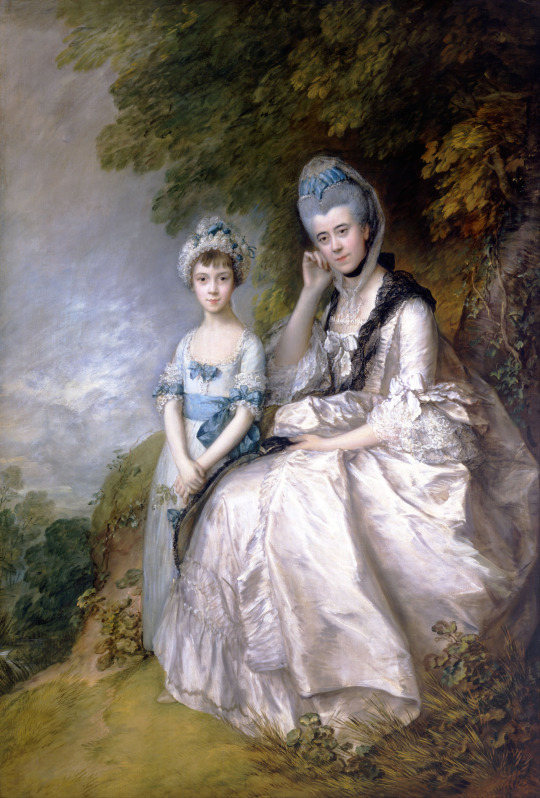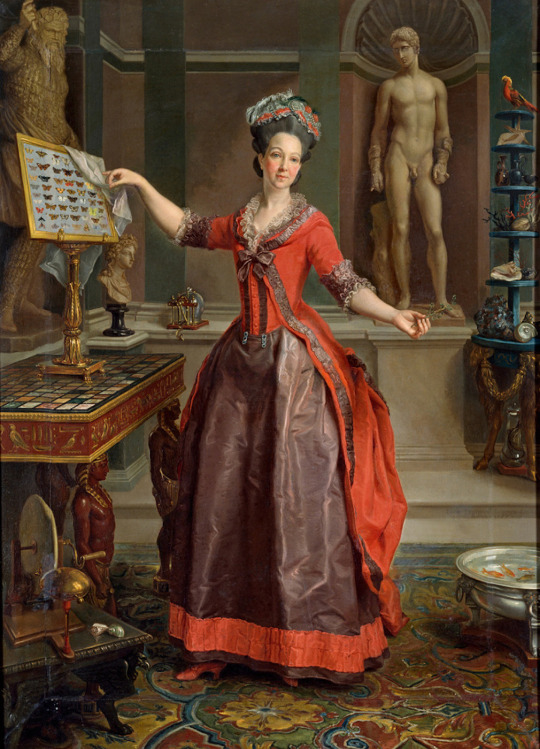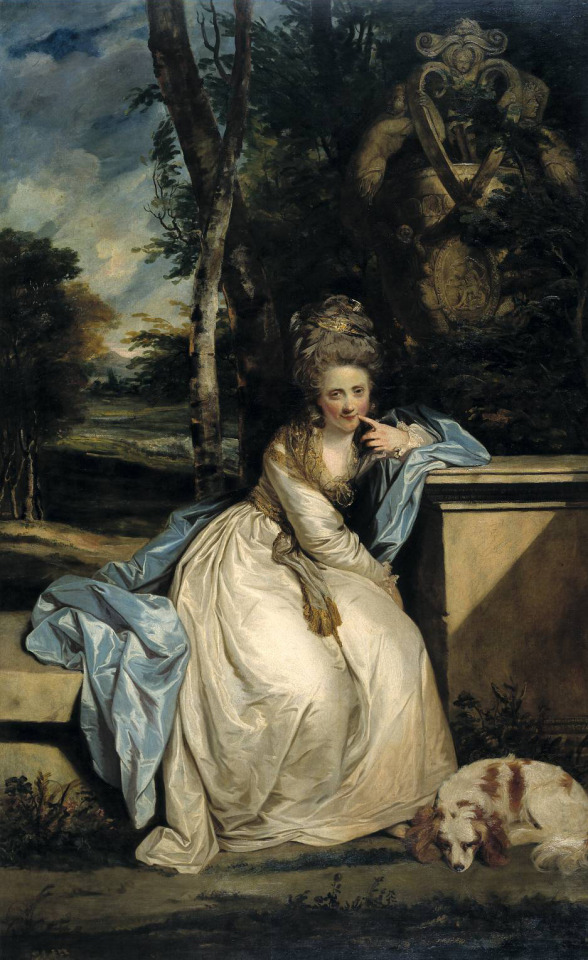#marie guimard
Explore tagged Tumblr posts
Text

Mademoiselle Guimard as Terpsichore by Jacques-Louis David, 1773-1775.
Context: portrait of Marie-Madeleine Guimard, a french ballerina. Terpsichore was the ancient greek muse of dance and chorus.
#classic art#painting#jacques louis david#french artist#18th century#portrait#female portrait#outdoor portrait#dancer#cupid#cupids#dogs in portraits#garden
122 notes
·
View notes
Photo





1770s portraits (from top to bottom) -
1771 Hester, Countess of Sussex, and Her Daughter, Lady Barbara Yelverton by Thomas Gainsborough (Toledo Museum of Art - Toledo, Ohio, USA). From Wikimedia.
1776 Charlotte Bettesworth (c.1755–1841), Mrs John Sargent by George Romney (Sudley House - Aigburth, Liverpool, Merseyside, UK). From bbc.co (now artuk.org).
1777 Margherita Sparapani Gentili Boccapadule by Laurent Pécheux (location ?). From tumblr.com/history-of-fashion/703331047465713664/1777-laurent-pécheux-margherita-sparapani; sized to fit screen 1010X1400 @72 464kj.
1777-1778 The Honourable Miss Monckton by Sir Joshua Reynolds (Tate Collection - London UK). From their Web site; removed spots throughout image with Photoshop.
Lady, said to be Marie-Madeleine Guimard by Jean-Frédéric Schall (auctioned by Christie's). From their Web site; there are too many spots to remove.
#1770s fashion#Rococo fashion#Louis XV fashion#Louis XVI fashion#Georgian fashion#Countess Hester of Sussex#Thomas Gainsborough#straight hair#high coiffure#head scarf#Charlotte Bettesworth#George Romney#long tight sleeves#Margherita Sparapani Gentili Boccapadule#Laurent Pécheux#zone bodice#shoes#Miss Monckton#Joshua Reynolds#full skirt#Marie-Madeleine Guimard#Jean-Frédéric Schall#feathered headdress#maxi-length skirt#flounces
38 notes
·
View notes
Text
What in Chevalier, the biopic film about Joseph de Boulogne chevalier de saint Georges, was wrong
SPOILER
Mozartvs Saint Georges: FALSE, never happened but they knew each other
Georges de Boulogne abandoned his son to de La Boëssière's school: FALSE, Georges loved his child, he never abandoned him
Nanon was a slave: NOT EXACTLY, she was born slavebut Georges freed her when Joseph was born, he created a second family with her and Joseph. he was married but he had only a daughter. For this reason he invested so much with his illegittimate son, he was the only male
Nanon arrived in France after George's death: FALSE, Nanon arrived in France with her son, she and George lived together in Paris until his death, madame de Boulogne lived in Nantes
Marie Antoniette named Joseph "chevalier de Saint Georges": FALSE, the title was used for the first time in 1766 whene Joseph was was made a Gendarme du roi, Saint Georges was one of his father's plantation. Marie Antoniette arrived in France only 5 years later
Joseph and Louis Philippe were friends: NOT EXACTLY, they were master and servant, not friends, they were close but not so much
Joseph and Marie Antoniette broke their friendship 'cause the French revolution: FALSE, he was is piano teacher, never his friend and he was an orleanist. Marie Antoniette and Louis Philippe hated each others since 1778 so and Joseph supported Louis Philippe
Marie Josephine was Joseph's real love: FALSE. Joseph's real love was the cornist Georges Lamothe, his childhood friend. Lamothe was the only white child Joseph knew when he was a child 'cause Lamothe's father was George du Boulogne's administrator. Georges Lamothe for all his life had only a pourpose: to love and to serve Saint Georges, he was madly in love, and everyone knew it, they were nicknamed as Orestes and Pylades. Joseph was a womanizer 'cause Lamothe was very jealous about other men, so... women yes but no men. They had a poly relationship with the singer Lousie Fusil
Guimard was jealous 'cause she was rejected: NOT EXACTLY, they had an affair but she hated be "one of the many"
Joseph discover his black heritage: NOT EXACTLY, he knew his heritage but he never cared too much
Nanon speaked an African languages: FALSE, she spoke creole, like her man and her son, Joseph had to learn a proper French when he arrived in France but he and Lamothe spoke creole when they were alone ;)
Joseph joined the Revolution 'cause he was denied the opera. FALSE, the opera scandal was in 1770s, he joined the revolution 'cause he was an orleanist, and he fell with the orlanist party
Stephanie de Genlis was Joseph's patroness: FALSE, he had a conctract as amateur for la comptesse de Montesson, Louis Philippe's secret stepmother, he was her first violin and he plays in her private theatre, with Lamothe oc
Marie Josephine was a singer: NOT EXACTLY, she was an amateur singer, not a professional
Joseph planned to elope with Marie Josephine: FALSE, she meant nothing to him, only the fling who gave him a son, he went to Haiti in 1793... with Lamothe
Marc René tried to arrest Joseph: FALSE. He discovered his wife was one of Joseph's lovers when she birthed a black son, he took the away the child and he order the famous assoult but he never had the power to arrest Joseph
and that's all, it could be a wonderfull film about a bisexual biracial men but it's only a good movie with some cheap love story
0 notes
Text

It was actually several women who publicly protested his appointment, saying that their “honour and their delicate conscience could never allow them to submit to the orders of a mulatto.” One of them was La Guimard, whose rejection by Saint-Georges is dramatized in the film, but is utterly without any historical basis that I’m aware of. St. George’s biographer, Gabriel Banat, suggests that it was actually La Guimard’s lover who arranged the whole thing, staging it in the most public possible manner to humiliate Saint-Georges. While I think that he makes an interesting argument, and definitely one that has merit, though...I’m not sure that we need an arch-mastermind to the entire affair. La Guimard was used to getting her own way, she wielded immense power at the opera. She didn’t want Saint-George to have sex with her, she wanted power, and I feel like that’s something that people skip. Isn’t it possible, and, in fact probable, given what we know about history and the racial dynamics, that three white women who were used to power just couldn’t stand to have a black man displace them and so they decided to cry about their delicate sensibilities in order to create a big enough scene that he ultimately didn’t take the position? (Saint-Georges withdrew his application, probably knowing that it would be better to do that and to give up that opportunity than to risk the scandal.)
Tldr: She was a racist who was used to getting her own way, there’s no evidence she wanted his dick.


Now, the actual debates over slavery in the revolutionary era, even among the Chevalier’s close political circle, is a complicated thing -- Brissot, for example, was strongly in favor of abolition, while de Laclos (yes, Dangerous Liaisons de Laclos) was in favor of keeping slavery. Many of the revolutionaries, if they weren’t outwardly in favor of slavery, considered it a necessary evil at the time. It shouldn’t have taken them up until 1794 to declare it illegal. But it’s vital to know that it was abolished during the Revolution (during the Terror, in fact), and that Napoleon Motherfucking Bonaparte took that away.
Now, as for the Chevalier’s motives for joining the Revolution...well, he was there from the beginning, employed by one of the single most famous aristocratic revolutionaries, Louis Philippe Joseph, the Duc d’Orléans, known in his later years as “Philippe Égalite.” But there was never a single moment where anyone went over to him and said “hello, would you like to join the revolution if we promise we’ll end slavery?” He was around him and his political circle, he was talking to them, mixing with them, he visited London, he met with abolitionists. He had a foot in both sides of the debate, as someone who maintained a cordial working relationship with Marie Antoinette through the early revolution but was also employed and seemingly in political sympathy with her arch-enemy.
And I’m putting an emphasis on that because I’ve noticed a certain push to remove any sense of agency from the Chevalier for his part in the Revolution -- Not necessarily here, but in general. “Oh, if he’d only known, of course he wouldn’t have joined. He was manipulated, he was led on, he was lied to.” Instead of acknowledging that the man had been in the Duc d’Orléans’ service for a decade by 1789; he was intelligent enough and savvy enough to know how the game worked. He’d been surviving in that world for his entire life. It didn’t mean that people *didn’t* make empty promises to him, it didn’t mean he didn’t suffer due to the Revolution, especially after Philippe’s death, but he made his own decisions based off of what he knew were the best possible options available at the time, and he did it with a remarkable sense of diplomacy and tact. His revolutionary sympathies were ultimately the result of careful consideration and observation, not empty promises and betrayal, even if those were the final result.


Hell, I'd be hype for this even if it weren't a true story!
49K notes
·
View notes
Photo

Jean-Frédéric Schall (1752-1825, French) ~ Portrait of a Lady (said to be Marie-Madeleine Guimard, called Mademoiselle Guimard, ballerina of the Paris Opéra (1743-1816), n/d
[Source: Christie’s]
38 notes
·
View notes
Text

jean honore fragonard
marie-madeleine guimard, 1765-1769, prima ballerina of the paris opera
6 notes
·
View notes
Photo

Mademoiselle Guimard as Terpsichore, by Jacques-Louis David
Marie-Madeleine Guimard (27 December 1743, Paris — 4 May 1816) was a French ballerina who dominated the Parisian stage during the reign of Louis XVI. For twenty-five years she was the star of the Paris Opera. She made herself even more famous by her love affairs, especially by her long liaison with the Prince of Soubise. According to Edmond de Goncourt, when d'Alembert was asked why dancers like La Guimard made such prodigious fortunes, when singers did not, he responded, "It is a necessary consequence of the laws of motion".
#Marie-Madeleine Guimard#Jacques-Louis David#XVIII century#XIX century#people#portrait#paintings#art#arte
64 notes
·
View notes
Text


Edwardian skirt by FreyaJewelryArtlab
Avalaible Here
Irina (from FreyaJewelryArtlab) was inspired by Hector Guimard design for his wife, sewed by les Soeurs Callot. Hector Guimard was was a French architect and designer, and a prominent figure of the Art Nouveau style. "les Soeurs Callot" is the name of a French haute couture house opened in 1895, 24 rue Taitbout in Paris in the 9th arrondissement by the four Callot sisters: Marie Callot-Gerber, Marthe Callot-Bertrand, Regina Callot-Tennyson-Chantrell and Joséphine Callot-Crimont.

The Original Design : Art Nouveau Embroidered Skirt, ca. 1900-05
via @ephemeral-elegance https://ephemeral-elegance.tumblr.com/post/128546974026/art-nouveau-embroidered-skirt-ca-1900-05

#arsenicinshell#victorian#edwardian#costume#skirt#artnouveau#french#hautecouture#historical#history#inspiration#victorian fashion#steampunktendencies#steampunk
160 notes
·
View notes
Photo

Portrait de Marie-Anne-Eléonore, comtesse de Grave (1730-1807), dit autrefois Portrait de Marie-Madeleine Guimard (1743-1816). Jean-Honoré Fragonard (French, 1732 - 1806)
ca. 1769
10 notes
·
View notes
Photo

Marie Madeleine Guimard, 1769, Jean-Honore Fragonard
Medium: oil,canvas
54 notes
·
View notes
Photo


Left: A portrait of Marie-Madeleine Guimard by Jacques Louis-David, circa 1773-1775.
Right: My Fair Valentine Barbie (1998); inspired by the above portrait. [image from Mattel’s official Barbie site]
2K notes
·
View notes
Photo

Portrait of ballerina Marie-Madeleine Guimard by Jean-Frederic Schall, late 1700s, France.
50 notes
·
View notes
Text










On a enfin vu, en famille, Dilili à Paris, de Michel Ocelot. Quelle merveille !
Certes, l’aventure est plaisante (et engagée !), la petite Dilili franco-kanak est effrontée et polie à souhait, mais ce qui m’a plu, évidemment, c’est la reconstitution détaillée de la Belle Époque, avec l’architecture Art Nouveau (ah les immeubles de Guimard, les affiches de Muscha !), les rêves pas si absurdes de Jules Verne, le boom de la science (Marie Curie et Louis Pasteur) et tous les artistes qui foisonnent dans la capitale, Sarah Bernhardt, Colette, Matisse, Monet, Renoir, Toulouse-Lautrec, Proust... et même Edward, le futur roi d’Angleterre !
J’adore le passage dans la demeure de Sarah Bernhart, avec son guépard ramené de Londres, le jardin extraordinaire et le lit non moins incroyable d’Emile Gallé avec sphinx et opale.
C’est très beau, et ça fait du bien de voir un dessin animé au rythme normal, avec des références culturelles et une idéologie humaniste et disons-le, féministe.
36 notes
·
View notes
Text
No Frontiers #4 - Paris
We showed 3 episodes of SHTV in Paris for Nofrontiers2021 a group exhibit curated by Mehdi Georges Lahlou. It's the first time shtv is being shown in a country where s** work is actually illegal.
There's other fab works about pressing related socio-political topics by artists including: Clay Apenouvon, Halida Boughriet, Camille Coléon & Audrey Guimard, Arianne Foks, Beya Gille Gacha, Soukaina Joual, Kubra Khademi, Mehdi-Georges Lahlou, Kokou Ferdinand Makouvia, Randa Maroufi, Kelly Sinnapah Mary, Fatima Mazmouz, Anna Raimondo, Enrique Ramirez, Pascale Rémita, Moussa Sarr, Massinissa Selmani


0 notes
Text
Two Creative Eras, One Design Aesthetic
This brooch, entitled Melusine, was designed by Marie-Claude Lalique and dates to about 1965. Made of thin gold wire, the brooch features the face of a woman whose hair swirls and coils into the wings of a butterfly. The piece is enhanced with a scattering of diamonds and emeralds.
The date of 1965 may be confusing because the brooch’s curvaceous design speaks the language of Art Nouveau, a style that was popular from approximately 1890 to 1910. Art Nouveau left behind the historicist styles common during the Victorian era, and is arguably the first original style of the modern age. The movement’s name, Art Nouveau – French for “New Art” – reflects its mission, and it revolutionized design across the board, in fine arts, architecture, and applied and decorative arts. “Rooted partly in the Industrial Revolution, and the Arts and Crafts Movement, but influenced by Japonism and Celtic design, Art Nouveau was given a major boost by the 1900 Exposition Universelle in Paris.”[1] Art and design in this style commonly used flowing, curving, organic lines, and elements from nature like birds, insects and flowers, as well as zoomorphic forms, figures that combine the human female form with elements of animals or insects.
In her brooch, Marie-Claude Lalique portrays an image of Melusine, a literary figure from European folklore. Melusine is a water sprite or siren, often portrayed as a woman with a fish’s tail. She is sometimes illustrated with wings, two tails or both. Certainly, a subject that would be akin to the zoomorphic creations of famed Art Nouveau artists like Lalique’s grandfather, René Lalique.
As noted, this pin dates not from 1900, but to about 1965, the era of Pop art and Psychedelic art. Psychedelic art, particularly as a form of graphic art, came about during the mid-1960s. It freely borrowed elements from Art Nouveau. Posters, album covers and advertising all featured images and lettering reminiscent of those created by Art Nouveau designers like René Lalique and Hector Guimard. This growing use of Art Nouveau elements was to become a trend which by the early 1970s imparted objects with voluptuous, organic line and form, reaching not only into publishing, but cinema and theater, fashion, hairdressing and domestic products.[2] Marie-Claude Lalique was on the forefront of the Art Nouveau revival.
Innovation was a family trait, starting with René Lalique, who began designing glass and jewelry in a little retail shop in Paris in 1905. The business grew and passed to his son, Marc, who was suceeded by his daughter, Marie-Claude, who took over the firm on his death in 1977. Focusing not only on the works in glass for which the company is best known, Marie-Claude added her own elaborate jewelry designs with precious stones and enamel.
Susan Teichman is a design historian specializing in the history of jewelry and synagogue architecture.
http://www.visual-arts-cork.com/history-of-art/art-nouveau.htm
http://www.thearttribune.com/Art-Nouveau-Revival-1900-1933-1966.html
.
from Cooper Hewitt, Smithsonian Design Museum https://ift.tt/2vaLfmZ via IFTTT
8 notes
·
View notes
Photo

"Panneaux Peints" provenant de la demeure de la danseuse Marie-Madeleine Guimard (1743-1816) à Pantin présentés à la conférence en ligne “Quelques Usages de la Céramique au XVIIIe Siècle" par Marie-Noëlle Mathieu sur #ExploreParis, juin 2021.
0 notes